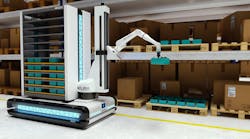The U.S. labor shortage continues to surge. The worker gap stands at 3 million, according to “Understanding America’s Labor Shortage,” an essay by Stephanie Ferguson, director, global employment policy & special initiatives at the U.S. Chamber of Commerce. October 2023 data show 9.5 million job openings with only 6.5 million unemployed workers, she notes.
The U.S. labor-force participation rate stands at around 63% with 1.7 million fewer workers than there were in February 2020, according to the chamber's America Works Data Center.
As more U.S. workers quit their jobs, many finding better opportunities in new industries, this leaves the door open for automation to lend a helping hand, or articulated arm, in tending the gap left by the labor reshuffle.
Japan faces a similar labor shortage impact in 2024 as new overtime regulations for truck drivers come into force. This is being called the “2024 problem.” Its potential disruptions need technological help. The world´s top robot-manufacturing country is developing automation strategies that will not only target logistical issues but also a wide range of industry challenges that the new working-time legislation will cause.
“The government´s overtime cap is an important step to improve working conditions for employees,” says Takayuki Ito, vice president of the International Federation of Robotics (IFR). “Industrial and service robots deliver great solutions to automate. Robots relieve workers of dirty, dull and dangerous work and help to close productivity gaps.”
In Japan, the average annual working hours for a heavy-truck driver were 2,568, which is 444 hours more than the national average for all jobs, according to labor ministry data from 2022. Placing cargo in and out of trucks and warehouses is one of the most time-consuming tasks of truck drivers. Mobile robots in transportation and logistics can help. Freeing up truck drivers from loading and unloading cargo saves them up to 25% of working time during a day´s shift, according to IFR. Robots also help reduce errors in order fulfillment by automating repetitive tasks such as picking and packing.
Warehouse robots in use today range from compact autonomous mobile robots (AMRs) to large-scale automated storage and retrieval systems. Their use reduces the amount of time required to move goods, and they can handle heavy loads and dangerous materials without putting human workers at risk.
“Regulations of overtime work and the demographic change will require the adoption of automation technology in many branches of the Japanese economy,” says Takayuki Ito. “The challenges of the trucking industry are good examples to show how robotics and automation deliver adequate solutions for our workplaces of the future.”





